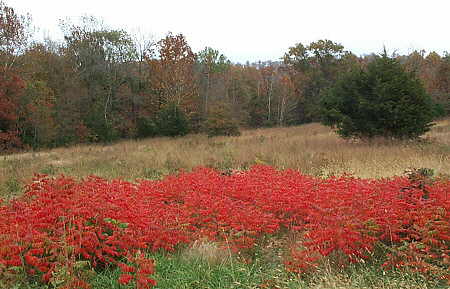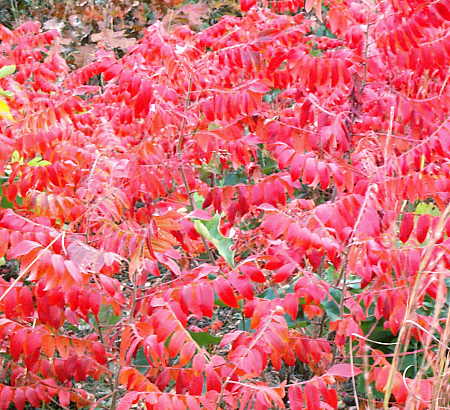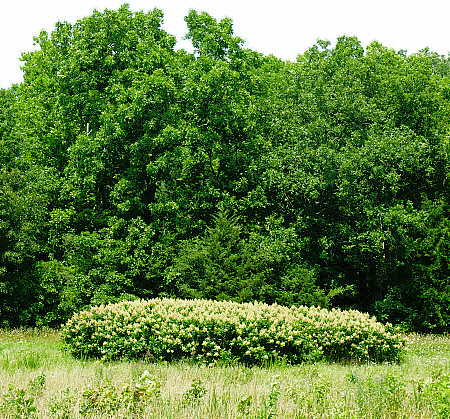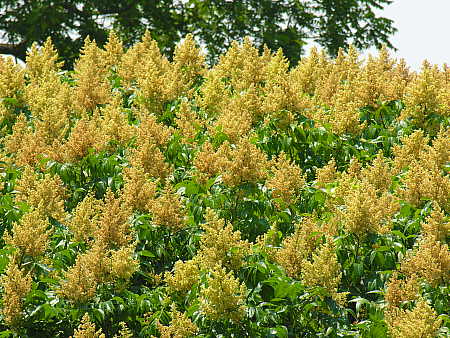Introduction
This is to be the first in a continuing series of posts in which I will attempt to portray the method by which I undertake landscaping projects here at the ranch. Before you can appreciate my style of landscaping, I must lay a little background. I know very little about the flora that surrounds me, and even less about the science of horticulture. I must further confess to having a near complete mental block when it comes to memorizing plant names and details of their existence. I have never understood why I can retain trivial facts for years and even decades, and yet, anything having to do with plants seems to evaporate from the nooks and crannies of my brain nearly immediately. I can recall the exact computer assembly language coding for the Fibonacci series that I learned in 1970, but I need to look up the names of common plants nearly every season!
Here is another piece of background information that influences my style of landscaping. I do not plant any plants, shrubs, or trees. With 330 acres to tend to around here, I find that there is a perpetual amount of work to be done just to maintain the neat appearance of the grounds that we enjoy so much. It might be different if I were able to always keep up with my maintenance schedule, but invariably, I find that I am usually playing catch up with necessary chores. When trying to keep the ever-encroaching wilderness at bay, the last thing I want to undertake is digging holes, transplanting, watering, fertilizing and fencing in additional species of plants or trees. To my way of thinking, on this much land, mother nature has provided a sufficient variety of species. All I need to do is simply appreciate it.
So, having said all of this, what exactly is my style of landscaping? It is merely my feeble attempt to encourage the growth of species that I enjoy, while discouraging the growth of species that I dislike, for whatever reasons. To illustrate the point that I am trying to convey, the first installment in this series portrays one encounter with a plant that inhabits this property. As additional installments of this series of posts appear on this blog, I think you will see a pattern developing – this pattern is what I am calling “Landscaping, My Way.”
Dwarf Sumac

In the fall of the first season that we lived on this property, there was a good amount of remedial and catch-up field work to be done. Some fields and pastures had been allowed to grow wild for many seasons, and decisions about their future use had to be made soon, or else we risked the prospect of having to re-establish these fields in the future. As I was busy bush hogging one of the fields, I ran across a patch of some bright red plant, which at the time, I could not identify. Whatever this plant was, it immediately caught my eye because of the intense color of the leaves, and I made an on-the-spot decision to spare their colorful lives. Instead of shredding them into oblivion, I decided to allow them to continue to grow, at least until I could take the time to learn more about them.

By gathering samples of the leaves and stems, I was able to identify this plant as a type of sumac, which occurs throughout most of the eastern United States. Later I learned that this was a species called dwarf sumac. The thin, reed-like stems of this plant, along with the opposing leaf structure make it easy to identify at a glance, and this made it easy to isolate and spare clusters of this plant in the fields where they grew. As a result of this ease in identification, soon I had numerous clusters of dwarf sumac growing in some of the fields. Each fall now brings numerous bright-red splotches of color into these fields, and a big grin onto my face when I see them in the course of my chores.

In the photo above you can see what a typical cluster of dwarf sumac looks like in the field during the month of July. The sumac is in bloom this time of year, and the creamy yellow flowers grow thick amidst the shrubbery.

The dense concentration of the bloom on these plants attracts the attention of any bees in the area. If you have any desire to “course bees” in order to locate elusive “bee trees”, these clusters of sumac are a good place to start. If you would like, click on this link to see my pictorial essay on “Hunting for Bee Trees.”
The sumac has year round nutritional value for wildlife. In the summer, many species of songbird dine on the prolific seed of the plant, joined by grouse and quail. Birds and many mammals partake of the berry-like fruit of the sumac, and deer love to browse the bark and stems of the plant in the winter. Native peoples of the eastern U.S. used the plant for medicinal purposes, and herbalists today utilize the root, leaf, and bark for a number of homeopathic remedies. So besides being a lovely, ornamental species that grows wild in this region, the plant brings with it numerous practical and beneficial properties.
Whenever I pass the many sumac patches that now exist in my fields, I can now say with pride, “that is the result of landscaping, my way.”



There are few things in the fall any prettier than a hillside of sumac and cedar. The contrast between the two is awesome. Love your “natural” method of landscaping!
330 acres!!! I would not know where to begin.
Gin – My “natural” method of landscaping comes out of necessity. The first time I had to dig a deep hole in our rocky hardpan soil, I (and my back) decided that another method was called for!
Sam – I usually don’t know where to begin either. Before this property, we lived on a boat. It was the size of a postage stamp by comparison, but even so, I never knew where to begin there also. This is one of the benefits of having a wife – she can supply a never-ending list of suggestions whenever I mutter “what should I do today?” 😉
What a great allround plant. I would have kept it too.
Pingback: Ranch Ramblins » Blog Archive » Can You Stand It?
Pingback: Ranch Ramblins » Blog Archive » Landscaping, My Way - Installment 2
Pingback: Ranch Ramblins » Blog Archive » The Fall Colors Keep Getting Better
Pingback: Ranch Ramblins » Blog Archive » Landscaping My Way - Installment #3